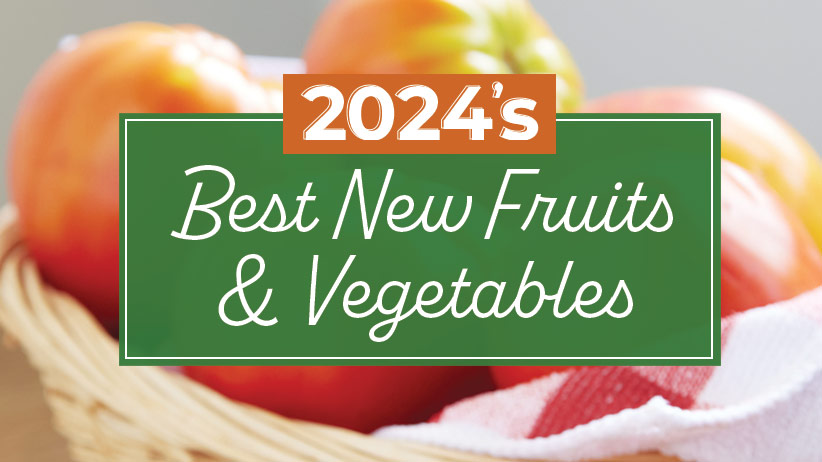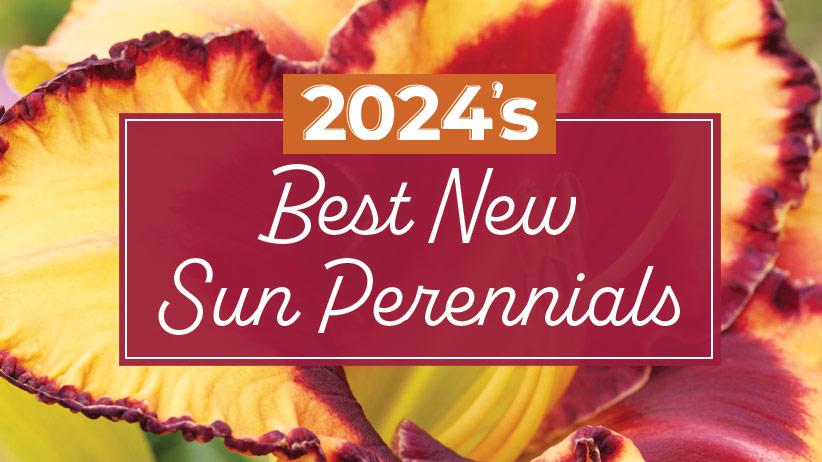Attract more birds to your garden
Your garden’s flowers fill your yard with beauty, color, shape and even fragrance. But that’s not where their interest ends — birds love plants, too! Throughout the year, seedheads, berries, nectar and fruit draw in winged visitors, such as songbirds and hummingbirds, providing them with the energy they need to perform essential functions, like flying, mating and migrating.
Provide shelter for the birds
Including a mix of trees and shrubs in your perennial border doesn’t just create more food options. It provides good cover, too, so birds can find shelter and feel protected while they eat. Now check out 6 plants birds love to eat below.
You Might Also Like:
Best-Selling Garden Books
DIY Bird Feeder Wreath
10 Plants to Attract Hummingbirds to Your Garden
How to Attract More Birds to Your Garden
DIY Terra-Cotta Bird Feeder

Coneflower (Echinacea spp. and hybrids)
It’s easy to have impressive masses of stunning blooms with low-maintenance coneflower. But don’t cut back the summer flowers once they start to fade. The pointed seedheads are favorites for many birds in the fall and winter months. Plus, the dried cones add interesting shape to the landscape through winter and help the native wildflower spread — deadheading spent blooms prevents reseeding. In spring, just cut stems back to the base of the plant.
Besides the native, purple coneflower (E. purpurea) that you see above, recent breedubg has produced a wider range of blooms colors to choose from. They all have mid- to dark green foliage that’s covered in small, rough hairs — a trait that deters deer and makes for strong drought tolerance.
Coneflower growing tips
- All coneflowers thrive in almost any type of soil, from dry to clay to rocky.
- Be sure plants get at least 6 hours of sun to ensure lots of blooms that will attract hummingbirds and even butterflies throughout the summer.
- Leave dried seed cones to attract other birds in fall and winter and add late-season interest to your garden.
- Cut stems back to the base of the plant in spring.
Birds that love coneflower
- Blue jays
- Finches (American goldfinch shown above)
- Northern cardinals
Coneflower key facts
Type Perennial Blooms Purple-pink, white, yellow, orange, green or red blooms from early summer to frost Light Full sun to part shade Soil Well-drained, but tolerates most types Size 1 to 4 ft. tall, 1 to 3 ft. wide Hardiness Cold hardy in USDA zones 3 to 9
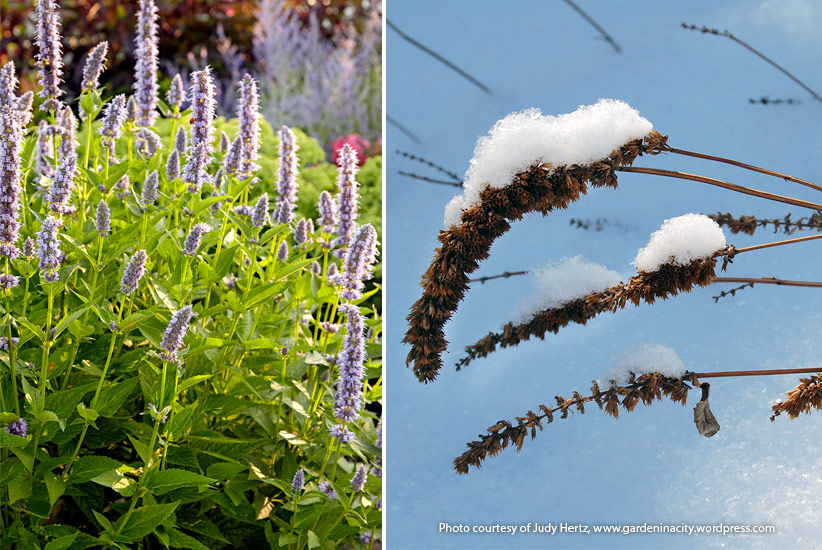
Anise hyssop (Agastache foeniculum)
Anise hyssop’s long-blooming blue flower spikes bring in hummingbirds, as well as butterflies and bees, from summer to fall.
‘Blue Fortune’ above has all the great qualities of the species, including drought tolerance and deer resistance. At 24 to 36 in. tall and 18 to 24 in. wide, this cultivar is more compact and a good choice for the middle of the border. Flowers stay upright on sturdy stems, and the foliage also has a pleasant black licorice fragrance.
Anise hyssop growing tips
- You can encourage more blooms early the season by snipping stems back to the next leaf joint as they fade.
- Leave spent stems standing in midfall, as flowers start to dry — finches love the clusters of tiny seeds. They hang on well into winter, providing energy when other food sources may be depleted.
- Be sure plants have a spot with well-drained soil — this perennial takes dry soil in stride, but its crown can rot in too much moisture.
Birds that love anise hyssop
- Finches
- Juncos
- Sparrows
Anise hyssop key facts
Type Perennial Blooms Blue flowers spikes from summer to fall Light Full sun to part shade Soil Well-drained Size 24 to 48 in. tall, 18 to 36 in. wide Hardiness Cold hardy in USDA zones 4 to 9

Annual sunflower (Helianthus annuus)
Want to bring in birds with annual sunflowers? Then the bigger the flower’s center, the better, so choose single stem (just one flower per plant) variety that has dinner-plate sized blooms, such as the one you see at above. That’s because larger seedheads mean more seeds from late summer on, as well as a better landing surface for winged visitors — whether you leave the drooping seedheads or cut and stick stalks elsewhere.
Annual sunflower growing tips
- These long-lasting flowers need full sun to bloom their best — this keeps stems strong, too, so you don’t have to stake leaning stalks.
- For the most color, blooms and birds, plant seeds in succession about 3 weeks apart, beginning right after the last frost and continuing through midsummer.
- Thin seedlings to 1 to 3 ft. apart, depending on the cultivar.
- The larger the flower’s center = more seeds for the birds!
Birds that love annual sunflower
- Buntings
- Cardinals
- Chickadees
- Grosbeaks
- Nuthatches
- Sparrows
- Woodpeckers
Annual sunflower key facts
Type Annual Blooms Shades of yellow, orange, white, red, burgundy or bicolor from midsummer to early fall Light Full sun Soil Moist, well-drained Size 10 to 180 in. tall, 8 to 30 in. wide
You Might Also Like:
Gardening For Birds
7 Must-Have Sunflowers
Best Plants with Berries for Birds
Bird-Feeding Obelisk Project
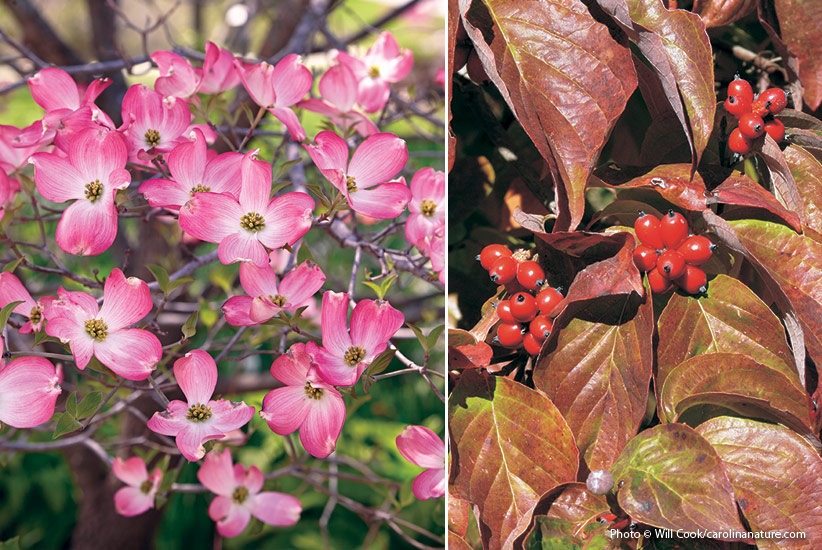
Flowering dogwood (Cornus florida)
Flowering dogwood’s showy white, red or pink petals are actually bracts. The flowers are the green-white buttonlike cluster at the center, and this is what matures to the bright early fall red fruits you see in the photo. Though inedible to humans, flowering dogwood berries are well-loved by birds and will hang on well into winter.
Flowering dogwood growing tips
- Low-branching with a relatively horizontal habit, this tree will still grow and bloom well under the canopy of larger trees. But for the most brilliant red fall foliage grow flowering dogwood in full sun.
- In areas with hot summers, flowering dogwood will benefit from some shade, especially early in the afternoon.
Birds that love flowering dogwood
- Bluebirds
- Dark-eyed junco
- Grosbeaks
- Tanagers
- Titmice
Flowering dogwood key facts
Type Tree Blooms White, pink or red in spring Light Full sun to part shade Soil Moist, well-drained Size 15 to 30 ft. tall and wide Hardiness Cold hardy in USDA zones 5 to 9
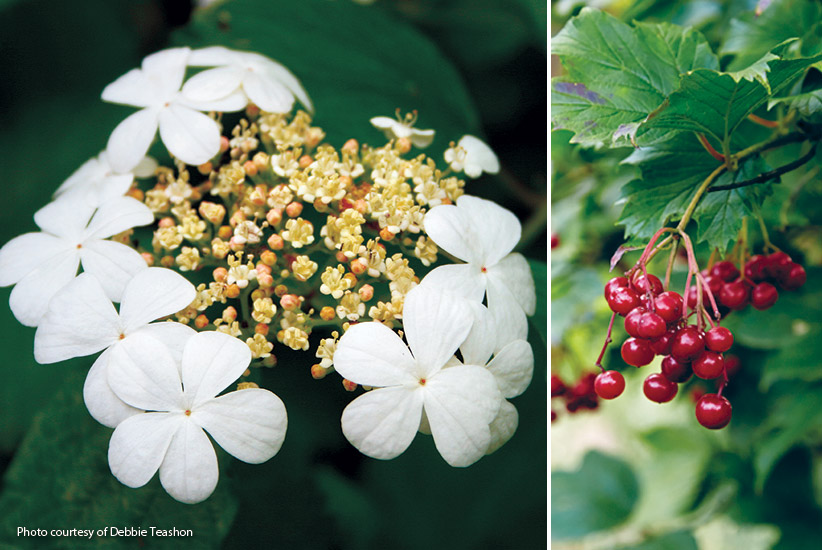
American cranberrybush (Viburnum opulus americanum)
You can get multiple seasons of interest from this shrub. Cranberrybush viburnum’s white lacecap flowers, above, bloom in spring, and in fall leaves take on tinges of purple and yellow. Tart and juicy bright red berries — similar to cranberries — form in late summer and feed birds in winter.
Dense summer foliage, along with a naturally rounded habit, make American cranberry bush a good hedge anywhere you need to add privacy or create a barrier.
American cranberry bush growing tips
- American cranberry bush handles a wide range of soils but does best in a moist, well-drained spot.
- To keep larger cultivars compact, prune after flowering finishes. Be patient, though — newly planted shrubs may not develop berries for a few years or until they’re well-established.
Birds that love American cranberry bush
- Cedar waxwing
- Grosbeaks
- Northern cardinal
- Robin
American cranberry bush key facts
Type Shrub Blooms White lacecap flowers in spring Light Full sun to part shade Soil Moist, well-drained loam; tolerates most types Size 8 to 12 ft. tall and wide Hardiness Cold hardy in USDA zones 2 to 8
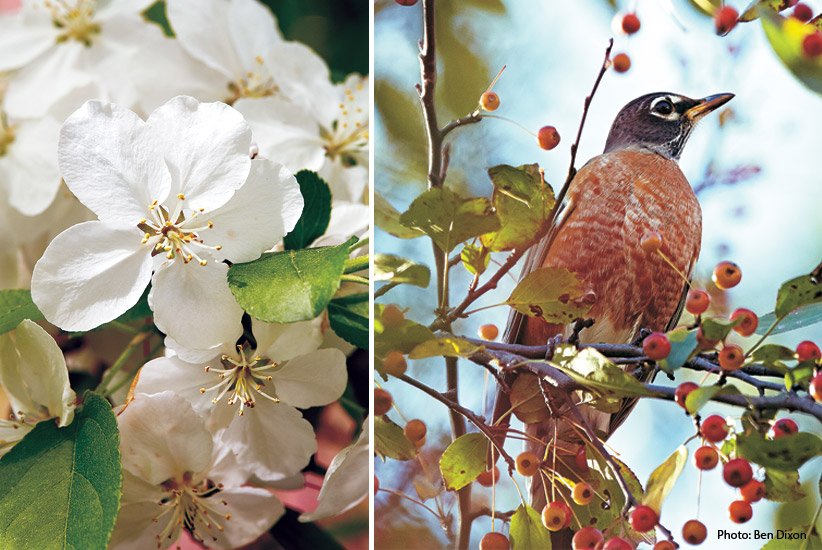
Flowering crabapple (Malus spp. and hybrids)
Flowering crabapple is practically synonymous with spring, and for good reason: Blooms almost cover the entire length of branches, filling the warming air with sweet fragrance. Besides its striking spring look, flowering crabapple produces red or yellow fruit that matures in late summer to early fall, depending on the cultivar. This brings in all kinds of birds, such as the American robin, above. Plus, crabapple fruit hangs on reliably into winter for birds to enjoy as the fruit softens after each freeze.
Thanks to a range of sizes and canopy shapes, you can plant flowering crabapple trees almost anywhere — even in small yards. And since many cultivars have foliage that changes hues as it matures, plant where you’ll have a good view of your tree to watch the color show, as well as the birds that visit.
Flowering crabapple growing tips
- Flowering crabapple tolerates most soil types but prefers a slightly acid pH range between 6.2 and 6.8.
- For the most flowers and fruit, give these trees a spot with full sun.
- To keep trees tidy, always cut back sucker growth at the base of the tree.
- If you need to prune branches, do so in late winter or early spring.
Birds that love flowering crabapples
- American robin
- Bluebirds
- Blue Jays
- Cedar waxwing
- Thrushes
- Wrens
Flowering crabapple key facts
Type Tree Blooms Fragrant pink or red buds open white, pink or purple in spring Light Full sun to part shade Soil Well-drained, slightly acid Size 6 to 25 ft. tall and wide Hardiness Cold hardy in USDA zones 3 to 9










